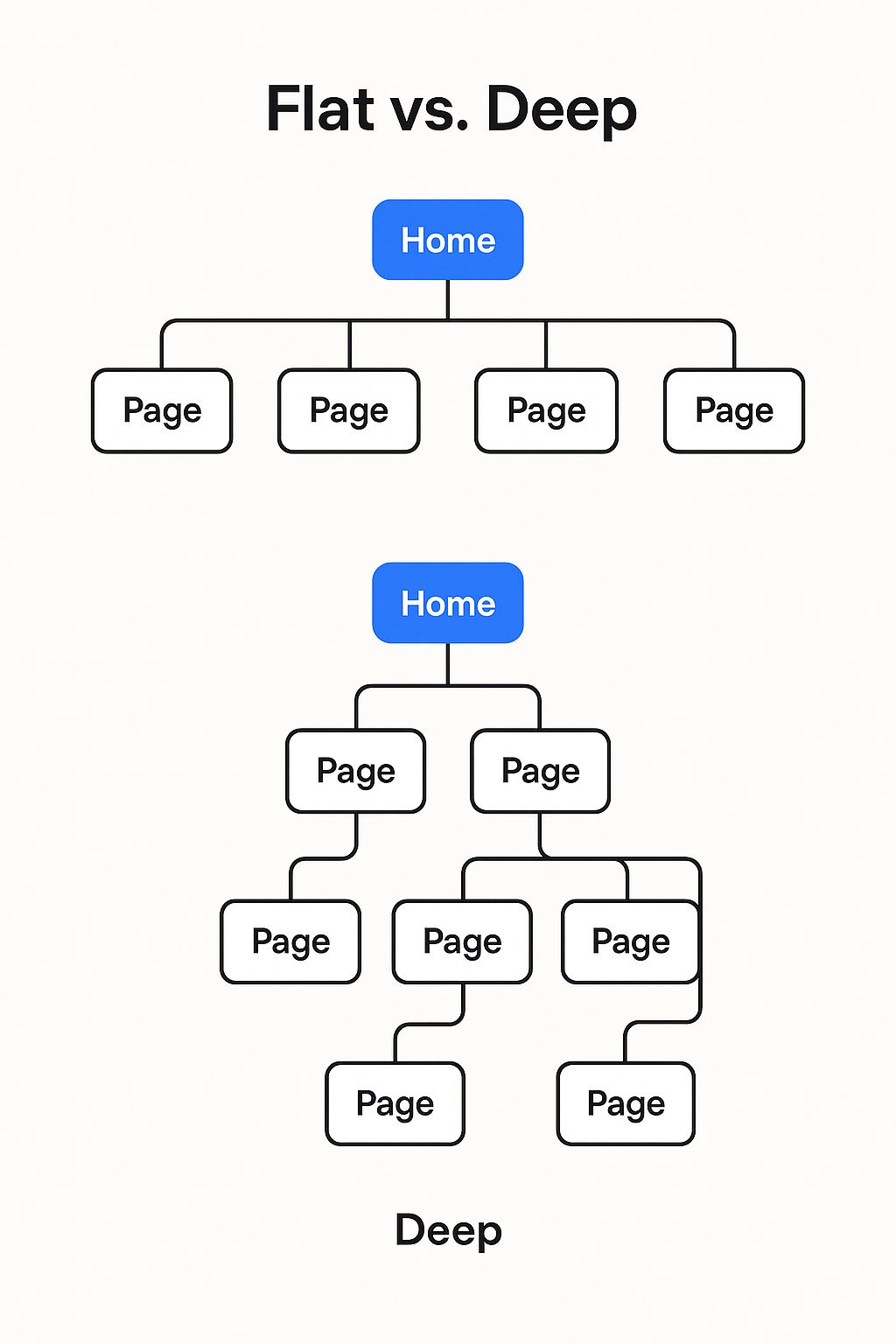If your website architecture feels like a maze, Google sees it that way, too.
Fix that, and you unlock faster indexing, better rankings, and a smoother user journey — all without rewriting a single blog post. The truth is, most sites don’t have a content problem — they have an architecture problem.
You could be producing high-quality content weekly, but if it’s buried five layers deep or floating around with no clear connections, it won’t get seen, let alone rank.
In this guide, we’re breaking down how SEO website architecture actually works, the different types of structures you can use, and how to plan and optimize your site the right way — so it scales with you.
Key Takeaways:
- Good architecture = good SEO. A clean structure helps Google crawl and understand your site better, which often leads to higher rankings.
- Flat > deep. Keep your most important pages within three clicks of your homepage.
- Topic clustering works. Organizing your content by topic and linking it intentionally boosts relevance and authority.
- URL structure matters. Clean, consistent, and keyword-aligned URLs improve crawlability and user trust.
- Don’t skip schema. Structured data helps Google extract meaning from your content and enables rich results in SERPs.
- Mobile-first is non-negotiable. Core Web Vitals and mobile usability are now baked into how Google evaluates your site.
If you’ve made it this far and still feel unsure about how to fix your site’s structure or scale your content strategy, I can help. This is what we do at Florens Kairos Digitals — build SEO systems that are clean, intentional, and built to rank long-term.
Feel free to reach out if you’d rather not figure it all out alone. Click this link to get started.
[ez-toc]
Why Website Architecture Matters for SEO
Website architecture, in simple terms, is how your pages are organized, linked, and discovered by search engines and users. Think of it like a well-organized library. If books (your pages) are dumped in random piles, readers can’t find what they need — and neither can Google.
But when everything is categorized, linked, and labelled properly? People stick around longer, and Google crawlers flow through effortlessly.
At its core, website architecture acts like the blueprint of a building — it determines how everything connects, flows, and functions behind the scenes. In SEO terms, that means how search engines discover, understand, and rank your content.
When done right, strong architecture boosts your visibility. When neglected, it buries your best content where no one (and no bot) can find it.
Let’s break down how it actually affects SEO performance:
- Crawlability and Indexation
Search engines don’t guess what’s important — they follow links. If your important pages are buried five clicks deep, disconnected from others, or not linked at all, Google may never crawl them. And if it doesn’t crawl a page, it won’t index it. Think of a subway system: if one major station isn’t connected to the rest of the network, no trains (or users) can get there. You could have the best info in the world, and it’d still be invisible.
- Internal Linking and Authority Flow
Good architecture allows link equity (PageRank) to flow from high-authority pages (like your homepage or top blog posts) to newer or less-trafficked pages. Internal links are like SEO currency transfers — they help Google decide what deserves to rank.
If your pages aren’t linked logically, they become “orphan pages” — live on your site but disconnected from the bigger picture.
A well-structured site spreads authority naturally, so even your lower-tier pages have a fighting chance in search results.
- User Experience (UX) and Engagement
Search engines measure how users behave on your site: how long they stay, how many pages they visit, whether they bounce immediately. If your architecture is confusing or cluttered, users get frustrated, and that reflects in your metrics. Let’s be honest: if someone lands on a cluttered page and can’t find the answer in two clicks, they’re hitting the back button. Google sees that. And it doesn’t look good.
On the flip side, clean structures with intuitive navigation often lead to higher engagement, longer session times, and more conversions.
- Topical Relevance and Content Discoverability
A well-organized site groups related content into clusters or silos. This helps both users and Google connect the dots. It sends a clear message: “Hey, we don’t just have one blog post on SEO (or whatever your target subject is…mine is SEO) — we’re an authority on it.”
This depth of coverage gives you better chances of ranking for both broad terms and long-tail queries.
It’s tempting to jump into SEO by optimizing blog posts, title tags, or loading speed. But if your site structure is weak, all those efforts are built on a shaky foundation. Before tweaking content, fix the architecture — it’s the silent force that holds everything up.
What Is SEO Website Architecture?
When people hear “website architecture,” they often picture wireframes or design layouts. But as you may have figured out by now, if you have managed to get to this point in this article, in SEO, it means something much more foundational: how your site’s content is organized, structured, and internally linked to help both users and search engines navigate it efficiently.
Imagine walking into a library with no sections, no labels, and books stacked at random. That’s what your site looks like to Google if the architecture is poorly planned.
SEO website architecture makes your content easier to crawl, easier to index, and easier to rank.
It’s not just a technical checklist — it’s a strategic framework for how search engines understand your site’s purpose.
Here are the key components of SEO website architecture:
- URL structure: Clean, readable URLs that follow a logical hierarchy.
- Internal linking: Pages that support each other by linking to related content.
- Navigation: Menus, breadcrumbs, and categories that help users move around.
- Content grouping: Pillars and clusters that signal topic relevance to search engines.
When all these elements work together, you don’t just make it easier for Google to crawl your site — you make it easier for users to find what they need, which in turn helps your SEO.
Keep in mind that this isn’t something you “set and forget.” As your site grows, the architecture has to evolve with it — otherwise it becomes bloated, fragmented, and frustrating to navigate (both for users and bots).
Understanding Website Structure Types
The thing is, not all site structures are created equal. Different types work better for different goals. But if you’re chasing strong SEO performance, two of them — flat architecture and silo/topic clustering — are usually your best bet.
Before we dig into those, it helps to understand the bigger picture.
Common Website Structure Models (Just for Context)
Here’s a quick rundown of structure types that exist across the web:
- Hierarchical (tree-like, most common in blogs and eCommerce)
- Sequential (step-by-step, often used in onboarding flows or learning platforms)
- Matrix (users decide path based on tags or filters; good for news or search-heavy sites)
- Database-driven (think Airbnb or Amazon, where content is pulled dynamically)
For SEO-focused websites — especially those publishing content — the hierarchical model forms the base. But how you layer your pages within that hierarchy makes the difference.
Flat vs Deep Site Structure
In a flat structure, all key pages are just a few clicks away from the homepage. It keeps things clean and crawlable. Search engines can find your content fast. And users? They don’t get lost in a rabbit hole of nested categories.
In contrast, a deep structure tucks content several levels down. This might make sense for massive eCommerce sites with thousands of SKUs, but it can hurt if important content becomes hard to reach or index.
Think of it like grocery shopping. In a flat structure, milk is right near the front. In a deep structure, you’re trekking past five aisles, two security doors, and a stockroom to find it. Guess where people are more likely to give up?
From an SEO perspective, the rule of thumb is: keep key pages within three clicks of the homepage. That’s your sweet spot for usability and crawlability.

Silo Structure and Topic Clustering
Here’s where SEO strategy and structure collide — in a good way.
Siloing is the practice of grouping related content under a broader topic or “pillar.” Each silo has a main page (your pillar) and several supporting pages (cluster content). It’s clean. Logical. And search engines love it.
Let’s say you run a fitness website. You could create silos like:
Pillar: Strength Training
Cluster: Beginner Workouts
Cluster: Dumbbell Routines
Cluster: Strength Nutrition
Pillar: Cardio
Cluster: HIIT vs Steady-State
Cluster: Treadmill Plans
Cluster: Heart Rate Zones
The point here is to show depth. Google wants to rank experts, not dabblers. By clustering related content and internally linking them together, you demonstrate authority in that subject area.
Topic clustering isn’t just good for SEO — it’s great for readers, too. It gives them a clear path to go deeper into subjects they’re interested in, without bouncing around randomly.
A lot of people jump into content creation without ever asking, “Where does this page fit in the bigger structure?” That’s like building a house without a floor plan.
Before you hit publish, you should know:
What topic cluster it belongs to, How it will be internally linked, What parent page gives it context
Because SEO isn’t just about keywords — it’s about building systems that help search engines and users find what they’re looking for, FAST.
How to Plan Your Site Architecture for SEO
If you’re thinking of structure as something you fix after launching a site, you’re already a step behind.
Good site architecture isn’t retrofitted. It’s intentionally planned — just like how architects sketch before builders lay bricks. You map out how pages will connect, how they’ll be found, and what role each one plays in the bigger SEO picture.
Let’s break that planning process down into a few key steps.
- Start with Keyword Research — Then Build Around It
Don’t create pages and hope they rank. Start by understanding what people are actually searching for.
Do your keyword research upfront — not just the high-volume head terms, but the related long-tail queries that make up the real traffic. Use this research to group your keywords into topics.
Each topic will eventually become a pillar page, with supporting content pages (cluster articles) built around it.
Example: If “Email Marketing” is a topic, your pillar page targets that exact phrase. Then you create cluster content for things like “best email subject lines,” “email marketing for ecommerce,” or “email drip campaigns.”
Planning this way helps you avoid overlapping content — and makes internal linking a breeze later on.
- Define Your Page Hierarchy (Don’t Over-Nest)
Every page on your site needs a home — and it needs to know who its neighbours are.
Start by mapping out your top-level categories, which usually align with the main pillars you identified in step one. Then nest subtopics underneath in a way that makes sense both to users and bots.
You don’t need a 5-level-deep menu with breadcrumbs that feel like a breadcrumb tax return. Most SEO-friendly structures use 2–3 levels max — especially for content-heavy or lead-gen websites.
A clear visual hierarchy also helps visitors make decisions faster. No one enjoys guessing where to click.
- Build Smart Navigation (That Reflects Your Structure)
Your menu isn’t decoration. It’s a map — and it should reflect the hierarchy you’ve created.
If your main nav is cluttered with random pages, or if it changes dramatically from one section to the next, you’re creating friction. That’s bad for UX and bad for SEO.
At a minimum, your main navigation should include:
- Your homepage
- Key category or service pages (pillars)
- A blog or learning hub
- Contact/about
Then, within each page, use breadcrumb navigation to help users (and Google) understand how they got there — and where they are.
- Map Your Internal Linking Strategy
Internal links are often treated like an afterthought, but they’re central to how architecture works for SEO.
Start by planning out which pages should point to which. Your pillar pages should link to all the clusters beneath them. And clusters should link back up — as well as sideways — to related content.
The goal is to keep readers moving through your site and to send clear signals to Google about content relationships.
Internal links also let you pass PageRank where it’s needed. That’s huge if you’re trying to lift newer or underperforming pages.
Like I mentioned earlier, site structure is NOT a one-time thing. It’s not. As your content grows, your structure needs maintenance — just like any high-performing system.
Pages get buried. Links break. Priorities shift. So revisit your structure regularly to clean up outdated paths, fix internal links, and ensure your hierarchy still reflects your SEO goals.
Best Practices for URL Structure & Crawlability
A lot of websites get content and design right — and still struggle to rank — because their URL structure is a mess. If your URLs confuse users or crawlers, you’re creating unnecessary friction. And in SEO, friction is expensive.
Let’s talk about what makes a clean, crawlable, and search-friendly URL structure — and how to make sure Google can move through your site the way you want it to.
- Keep URLs Short, Descriptive, and Predictable
Good URLs don’t try too hard. They describe what’s on the page — no more, no less. The best ones are readable even without a title tag.
Instead of: yoursite.com/blog?id=8283&ref=abc
Use: yoursite.com/blog/seo-site-architecture
There’s a subtle benefit here: clarity builds trust. Users are more likely to click URLs that look straightforward. And Google has said time and again — simpler is better.
Also, avoid stuffing keywords. One well-placed term is enough. More than that starts to look manipulative and can make your site feel spammy.
- Use Hyphens, Not Underscores
Hyphens are the standard delimiter between words in URLs. They’re easier to read and more search-friendly.
This might feel minor — but from an indexing perspective, it helps Google parse words accurately.
Correct: yourdomain.com/seo-best-practices
NOT correct: yourdomain.com/seo_best_practices
- Use Lowercase Only
URLs are technically case-sensitive. So if /Blog/SEO and /blog/seo both exist, Google sees them as different pages.
Stick with lowercase across the board. It’s cleaner, easier to remember, and avoids duplicate content headaches.
- Match URLs to Site Hierarchy
Your URLs should reflect your site’s structure. If a page lives under the “services” section, it should look like it does.
Example:
yourdomain.com/services/seo-audit (Good)
yourdomain.com/seo-audit (Okay, but not as clear)
When URLs follow your site’s hierarchy, they help with breadcrumb setup, logical navigation, and — maybe most importantly — help users understand where they are on your site.
- Avoid Dynamic Parameters (When Possible)
URLs with ?id=1234&source=email may work for analytics, but they’re not ideal for SEO. Search engines can crawl them, sure, but it creates complexity — especially if you’re not handling canonical tags properly.
Stick with static URLs for your main pages. Reserve parameters for tracking or faceted navigation — and even then, make sure they’re blocked or canonicalized correctly.
- Use Canonical Tags to Handle Duplicate URLs
Sometimes the same content exists at multiple URLs (e.g., due to filters, pagination, or tracking). Use the <link rel=”canonical”> tag to tell Google which version is the “master.” or original.
This keeps your indexing clean, avoids keyword cannibalization, and concentrates link equity where it matters.
- Submit an XML Sitemap — and Use an HTML One Too
An XML sitemap helps Google discover every important URL on your site — especially if they’re new or lightly linked. Submit it via Google Search Console and keep it updated.
But also consider adding an HTML sitemap (a regular page with internal links to key pages). This is often overlooked, but it’s great for crawlability and user navigation.
- Block Crawl Traps and Wasted Paths
There are parts of your site you don’t want Google to waste time crawling — like Login pages, Filter combinations that create infinite URLs, Admin panels or duplicate sort orders.
Use robots.txt or meta tags to politely tell Google “skip this.” You only get so much crawl budget — don’t waste it.
Most SEO advice around URLs focuses on ranking — but structure also impacts how scalable your site is. Clean URLs are easier to manage, redirect, and monitor. When you start building out hundreds of pages, you’ll thank yourself for keeping it tidy from day one.
Optimizing Internal Linking & Crawl Budget

Internal links are more than just pathways between pages — they’re instructions for how search engines understand, crawl, and prioritize your content. When used strategically, they help you get more of your site indexed, and make better use of your crawl budget.
If you’ve never heard that term before, crawl budget is basically how many pages Googlebot is willing (and able) to crawl on your site within a given time frame. It’s not infinite. And if you’re wasting crawl activity on dead-end pages, redirect chains, or duplicated content, your important pages might never get seen — let alone ranked.
Every internal link you add helps shape how search engines move through your site. The more logically connected your content is, the easier it is for bots to crawl deeper and understand topical relationships.
Let’s say you have a service page for “RF Microneedling.” You’ve also got blog posts explaining how it works, how it compares to other treatments, and how it helps different skin types. Each of those posts should link back to the main service page — and vice versa. That’s not just good for SEO — it helps users find answers faster, too.
But here’s the key: don’t just link for the sake of it. Context matters. Links should feel natural, not forced, and they should connect related content. Otherwise, you’re just adding noise.
Google doesn’t promise to crawl your whole site. Especially if it’s large, slow, or poorly structured. What it does is allocate a budget — and how efficiently you use that budget can directly affect how much of your content gets indexed.
A few things that kill crawl efficiency:
- Pages that return errors (404s, server issues)
- Long redirect chains (301 > 302 > 301 > finally the content)
- Orphan pages — ones that have no internal links pointing to them
- Overuse of parameterized URLs or faceted navigation with no canonicalization
- Huge pages that exceed Google’s 15MB processing limit
If Googlebot has to wade through all that just to find your good content, you’re leaving SEO performance on the table.
So How Do You Fix It?
- Keep important pages close to your homepage — ideally within three clicks.
- Use a flat site structure, and avoid over-nesting.
- Link topically related pages together — don’t just rely on nav menus.
- Create an HTML sitemap and include links to all critical pages.
- Use tools like Screaming Frog or Ahrefs to find orphaned pages, broken links, and crawl traps.
- Noindex pages that aren’t adding value (tag archives, test pages, low-quality duplicates).
As you scale your content, internal linking and crawl management aren’t optional — they’re foundational. It’s not just about publishing more pages. It’s about making sure those pages get discovered and ranked in the first place.
Optimizing for Mobile-First and Core Web Vitals
By now, most site owners know that mobile optimization matters. But what many still underestimate is how directly it ties into your search visibility. Google has been mobile-first in its indexing for years, meaning it evaluates your mobile version first — not as a fallback.
And with Core Web Vitals, Google isn’t just crawling your content — it’s judging the experience behind it.
Let’s break this down clearly and practically.
Mobile-First Isn’t a Trend — It’s the Default
When someone visits your website on their phone, what do they see? If your mobile layout is squished, clickable elements are too close together, or your menu is more maze than map, Google sees it — and users feel it.
To align with mobile-first indexing:
Make sure your mobile and desktop content are nearly identical — including structured data, meta tags, and internal links.
Use responsive design that adapts across screen sizes, not a separate mobile subdomain.
Avoid hiding content on mobile that’s visible on desktop. If it’s important, it should show up everywhere.
You don’t get to choose which version Google sees first. It’s mobile by default now — and if it’s broken, so is your SEO.
How Page Performance Impacts Crawlability and Technical SEO
Core Web Vitals measure how fast and stable your site feels to real users. And yes — they’re part of Google’s ranking systems.
There are three key metrics:
- LCP (Largest Contentful Paint): How quickly your main content loads.
- FID (First Input Delay → now INP): How quickly your site responds to user input.
- CLS (Cumulative Layout Shift): How much the page jumps around while loading.
If you’ve ever clicked something and had it slide away as the page loaded? That’s CLS in action — and it’s frustrating.
To optimize these metrics, load key content (images, text) first. Use compressed images and lazy loading. Avoid injecting banners, ads, or cookie bars that shift content down unexpectedly. Use a reliable hosting stack — performance starts with your server.
To put all I just said in perspective, a homepage that takes 3.5s to load and shifts the call-to-action button mid-load can quietly sabotage conversions — and send your Web Vitals score into the red.
Structured Data and Schema in SEO Website Architecture
Throughout this article, I have touched on menus, page hierarchies, and internal links. But under the hood, there’s another layer that plays a huge role in helping search engines understand your site: structured data, specifically, schema markup.
And no, this isn’t just for developers. Schema impacts how your site appears in search results, how it’s interpreted by Google, and whether or not you earn rich results like FAQs, reviews, and product stars.
Let’s break it down in a non-technical, real-world way.
Structured data is a format (usually in JSON-LD) that labels pieces of content on your pages — telling Google exactly what they are. It’s like placing a name tag on every key element:
“This is a product.”
“This is an author.”
“This is an FAQ.”
Without structured data, Google has to make guesses based on your HTML and content. With schema, you hand it the answers on a silver platter.
For example, if you run a recipe site, structured data can highlight ingredients, cook time, nutrition info, and ratings. The result? A beautiful, expanded search result that stands out on page one.
But this goes deeper than rich snippets — it reinforces your overall site architecture by establishing clearer relationships between your content types.
How Schema Supports SEO Architecture
- Clarifies Page Roles: In a well-structured site, each page has a specific role (e.g., service page, blog article, how-to). Schema gives Google extra signals about that role. That makes it easier for the engine to sort, display, and rank your pages appropriately.
- Improves Discoverability: Schema enhances your crawlability and indexation — especially when paired with a clean hierarchy and strong internal linking. For larger sites, it can be the difference between getting buried and being found.
- Enables Rich Results: These include star ratings, product pricing, video previews, event dates, breadcrumbs — all the little extras that make your search listing more clickable. The right structured data is what powers those enhancements.
- Supports Entity Relationships: Schema isn’t just about marking up individual items — it also shows how things connect. For instance, you can link a blog post to its author profile, a review to its product, or a course page to a local business.
This builds semantic depth — a critical factor as search engines move beyond keywords and into contextual understanding.
Best Practices (Without Getting Overwhelmed)
- Use Google’s Structured Data Markup Helper if you’re not a dev, or Technical Seo Schema Markup Generator (a personal favourite of mine)
- Prioritize schema for content types Google supports: articles, products, FAQs, how-tos, breadcrumbs, videos, and local business.
- Avoid marking up content that isn’t actually on the page (this can get you penalized).
- Test your markup using Google’s Rich Results Test and Schema Markup Validator
You don’t have to apply schema site-wide on day one. Start with your most important pages — especially those already ranking or earning traffic — and layer in markup from there.
Structured data isn’t a shortcut to page one. But it is a signal booster — one that clarifies your architecture, elevates your presence in search, and nudges your site closer to expert-level recognition in Google’s eyes.
Common Mistakes to Avoid in SEO Website Architecture
Even with the best intentions, small missteps in your site’s structure can quietly sabotage performance. Here’s what to watch out for — and why they matter:
- Burying Key Pages Too Deep in Your Site
If a user (or Googlebot) has to click five or six times from the homepage just to find a key service page, that’s a problem. Important pages should never be more than three clicks away — ideally two.
Say your top-converting page is an in-demand service, but it’s only accessible through a blog post > a tag page > a category > and finally the link. That page might never get crawled efficiently, let alone rank.
- Creating Too Many “Lone Wolf” Pages
These are pages that don’t link to anything else on your site and receive no links in return. No context. No traffic flow. No authority.
If you have service pages that exist in isolation — no sidebar links, no footer presence, and no mention in blog content — they’re unlikely to be crawled or indexed consistently.
- Ignoring Internal Linking Altogether
A strong internal linking strategy is like a map for both users and bots. If every page just exists on its own island, you miss the chance to pass authority and build relevance across your content ecosystem.
If someone lands on your Potenza RF microneedling page, they should be able to jump to related treatments, FAQs, or comparisons — without relying on the back button.
- Using Overly Complex or Ugly URLs
URLs like /page-id=103?ref=xyz might work for devs, but they confuse users and search engines alike. Use URLs that describe what the page is actually about — simple, lowercase, and hyphen-separated.
Clean: drlianbeauty.com/laser-hair-removal
Messy: drlianbeauty.com/svc/123-hair-lsr/
Guess which one gets clicked more.
- Overlapping or Competing Pages
If you have two blog posts covering almost the same topic — “Benefits of Microneedling” and “Why Try RF Microneedling?” — Google won’t know which to rank. Worse, it might rank neither.
Instead of creating near-duplicates, merge and strengthen the content, then redirect the weaker one to the better version.
Tools to Help You Audit & Improve Your Website Architecture
- Screaming Frog: Crawl your site and uncovers technical issues like broken links, duplicate content, and missing headers or metadata.
- Ahrefs Webmaster Tools: Free website analytics, technical audit & SEO metrics for your verified websites.
- Google Search Console: Free Google tool that tracks impressions, clicks, rankings, and CTR — plus helps you spot and fix technical issues to keep your site healthy and SEO-ready.
- MindMeister or Xmind : For Content mapping and organization, and visual representation of content relationships
Fixing your website’s architecture isn’t flashy, but it pays long-term dividends. It improves your rankings, reduces wasted crawl budget, and delivers a smoother, more engaging experience to real people.
It’s the kind of fix that makes everything else work better.
So whether you’re launching a new site or fixing an old one, start with structure. That’s your SEO foundation.





